BUS5002D: Business Processes, Quality, and Innovation at Volkswagen
VerifiedAdded on 2023/01/09
|16
|5571
|40
Report
AI Summary
This report provides a comprehensive analysis of Volkswagen's business processes, examining its quality management approaches, particularly Total Quality Management (TQM), in comparison to Ford's lean manufacturing. It delves into various methods for measuring project success, including stakeholder evaluation, goal accomplishment assessment, and end-user adoption. The report outlines key principles of effective project management, such as clear project descriptions, defined objectives, progress disclosure, risk assessment, and the importance of an effective project manager. Additionally, it explores techniques for analyzing and improving organizational processes, with an emphasis on how these analyses generate opportunities for innovation and growth within Volkswagen, culminating in an implementation plan to capitalize on identified opportunities. The report aims to provide insights into how VW can enhance its operations and achieve its strategic objectives.
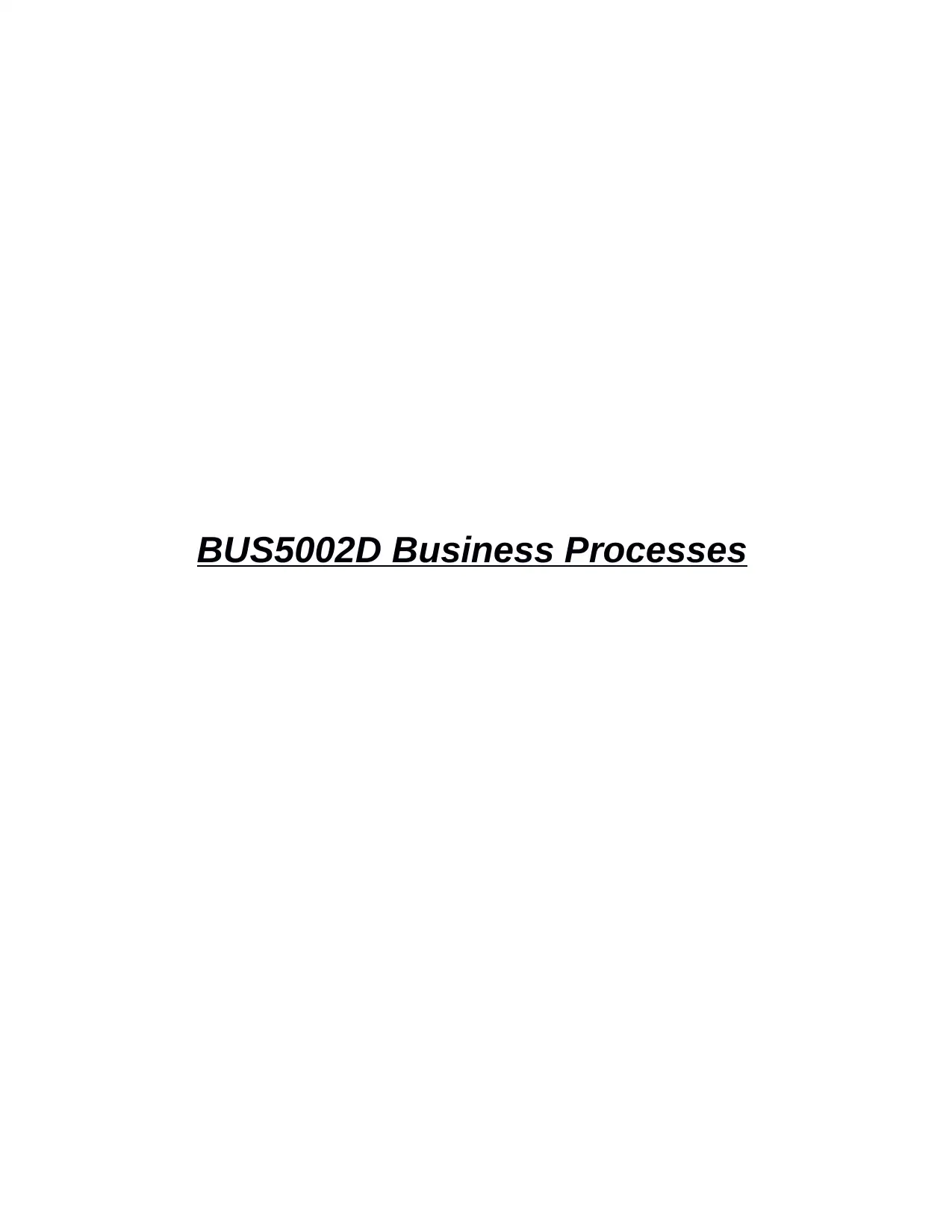
BUS5002D Business Processes
Paraphrase This Document
Need a fresh take? Get an instant paraphrase of this document with our AI Paraphraser
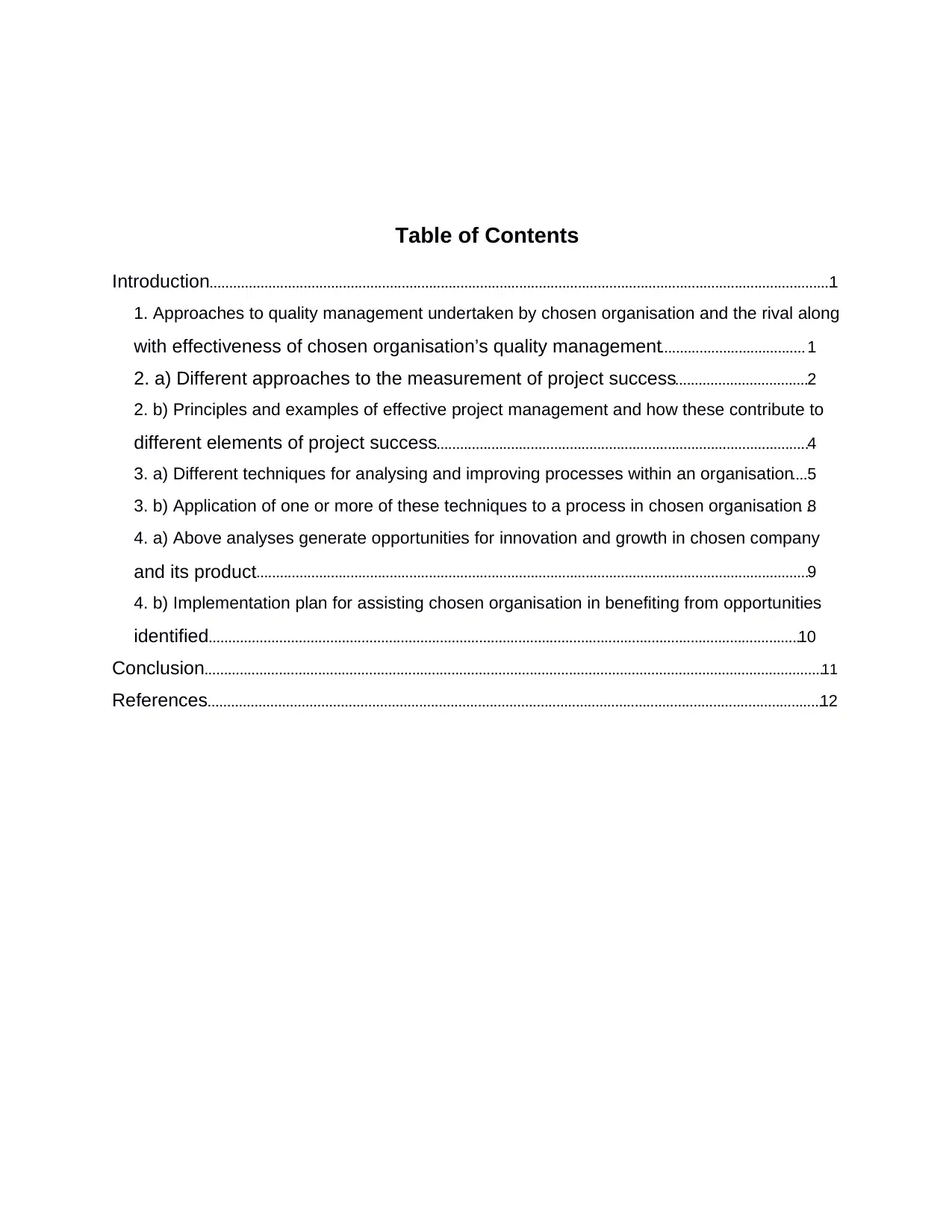
Table of Contents
Introduction...............................................................................................................................................................1
1. Approaches to quality management undertaken by chosen organisation and the rival along
with effectiveness of chosen organisation’s quality management..................................... 1
2. a) Different approaches to the measurement of project success..................................2
2. b) Principles and examples of effective project management and how these contribute to
different elements of project success...............................................................................................4
3. a) Different techniques for analysing and improving processes within an organisation....5
3. b) Application of one or more of these techniques to a process in chosen organisation. .8
4. a) Above analyses generate opportunities for innovation and growth in chosen company
and its product.............................................................................................................................................9
4. b) Implementation plan for assisting chosen organisation in benefiting from opportunities
identified.......................................................................................................................................................10
Conclusion..............................................................................................................................................................11
References.............................................................................................................................................................12
Introduction...............................................................................................................................................................1
1. Approaches to quality management undertaken by chosen organisation and the rival along
with effectiveness of chosen organisation’s quality management..................................... 1
2. a) Different approaches to the measurement of project success..................................2
2. b) Principles and examples of effective project management and how these contribute to
different elements of project success...............................................................................................4
3. a) Different techniques for analysing and improving processes within an organisation....5
3. b) Application of one or more of these techniques to a process in chosen organisation. .8
4. a) Above analyses generate opportunities for innovation and growth in chosen company
and its product.............................................................................................................................................9
4. b) Implementation plan for assisting chosen organisation in benefiting from opportunities
identified.......................................................................................................................................................10
Conclusion..............................................................................................................................................................11
References.............................................................................................................................................................12
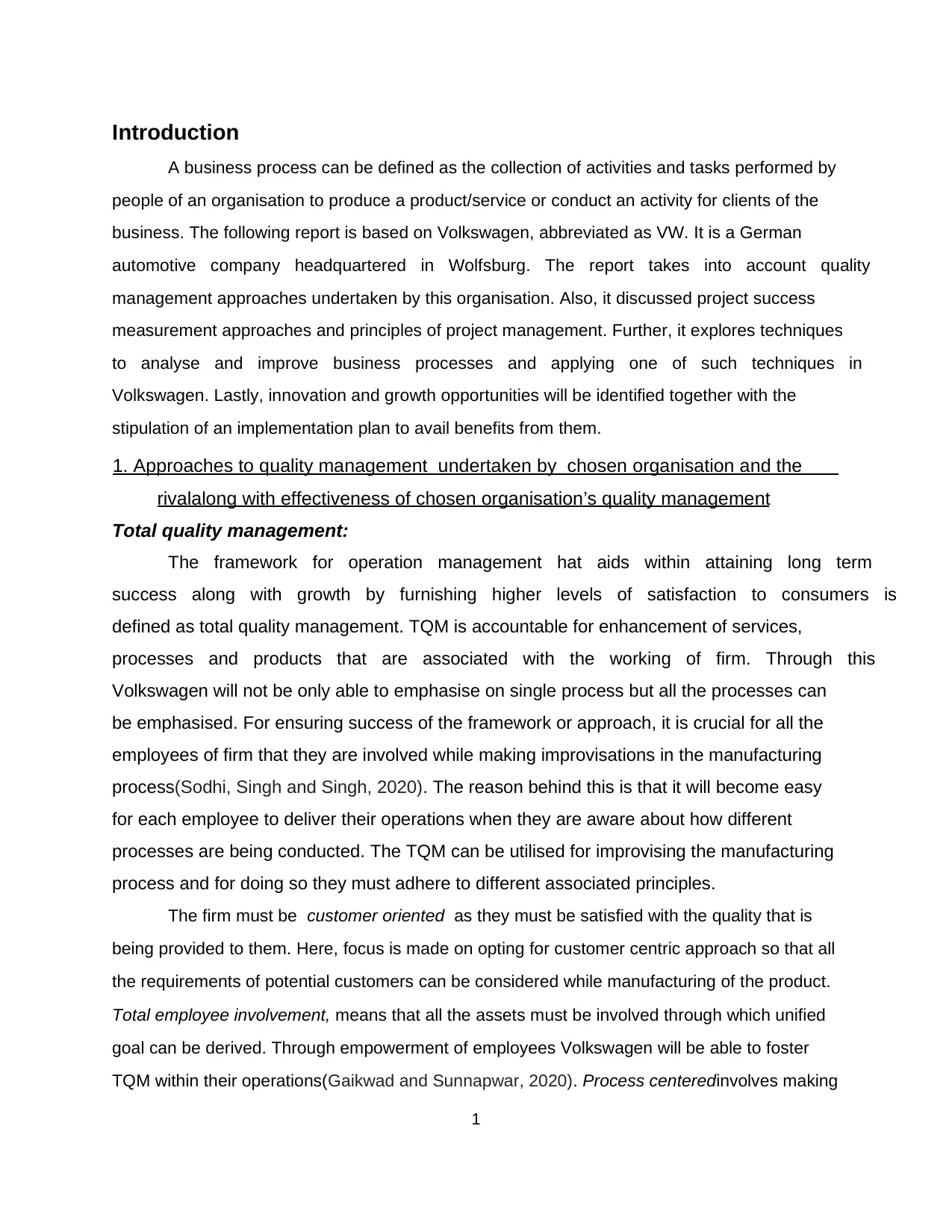
Introduction
A business process can be defined as the collection of activities and tasks performed by
people of an organisation to produce a product/service or conduct an activity for clients of the
business. The following report is based on Volkswagen, abbreviated as VW. It is a German
automotive company headquartered in Wolfsburg. The report takes into account quality
management approaches undertaken by this organisation. Also, it discussed project success
measurement approaches and principles of project management. Further, it explores techniques
to analyse and improve business processes and applying one of such techniques in
Volkswagen. Lastly, innovation and growth opportunities will be identified together with the
stipulation of an implementation plan to avail benefits from them.
1. Approaches to quality management undertaken by chosen organisation and the
rivalalong with effectiveness of chosen organisation’s quality management
Total quality management:
The framework for operation management hat aids within attaining long term
success along with growth by furnishing higher levels of satisfaction to consumers is
defined as total quality management. TQM is accountable for enhancement of services,
processes and products that are associated with the working of firm. Through this
Volkswagen will not be only able to emphasise on single process but all the processes can
be emphasised. For ensuring success of the framework or approach, it is crucial for all the
employees of firm that they are involved while making improvisations in the manufacturing
process(Sodhi, Singh and Singh, 2020). The reason behind this is that it will become easy
for each employee to deliver their operations when they are aware about how different
processes are being conducted. The TQM can be utilised for improvising the manufacturing
process and for doing so they must adhere to different associated principles.
The firm must be customer oriented as they must be satisfied with the quality that is
being provided to them. Here, focus is made on opting for customer centric approach so that all
the requirements of potential customers can be considered while manufacturing of the product.
Total employee involvement, means that all the assets must be involved through which unified
goal can be derived. Through empowerment of employees Volkswagen will be able to foster
TQM within their operations(Gaikwad and Sunnapwar, 2020). Process centeredinvolves making
1
A business process can be defined as the collection of activities and tasks performed by
people of an organisation to produce a product/service or conduct an activity for clients of the
business. The following report is based on Volkswagen, abbreviated as VW. It is a German
automotive company headquartered in Wolfsburg. The report takes into account quality
management approaches undertaken by this organisation. Also, it discussed project success
measurement approaches and principles of project management. Further, it explores techniques
to analyse and improve business processes and applying one of such techniques in
Volkswagen. Lastly, innovation and growth opportunities will be identified together with the
stipulation of an implementation plan to avail benefits from them.
1. Approaches to quality management undertaken by chosen organisation and the
rivalalong with effectiveness of chosen organisation’s quality management
Total quality management:
The framework for operation management hat aids within attaining long term
success along with growth by furnishing higher levels of satisfaction to consumers is
defined as total quality management. TQM is accountable for enhancement of services,
processes and products that are associated with the working of firm. Through this
Volkswagen will not be only able to emphasise on single process but all the processes can
be emphasised. For ensuring success of the framework or approach, it is crucial for all the
employees of firm that they are involved while making improvisations in the manufacturing
process(Sodhi, Singh and Singh, 2020). The reason behind this is that it will become easy
for each employee to deliver their operations when they are aware about how different
processes are being conducted. The TQM can be utilised for improvising the manufacturing
process and for doing so they must adhere to different associated principles.
The firm must be customer oriented as they must be satisfied with the quality that is
being provided to them. Here, focus is made on opting for customer centric approach so that all
the requirements of potential customers can be considered while manufacturing of the product.
Total employee involvement, means that all the assets must be involved through which unified
goal can be derived. Through empowerment of employees Volkswagen will be able to foster
TQM within their operations(Gaikwad and Sunnapwar, 2020). Process centeredinvolves making
1
⊘ This is a preview!⊘
Do you want full access?
Subscribe today to unlock all pages.

Trusted by 1+ million students worldwide
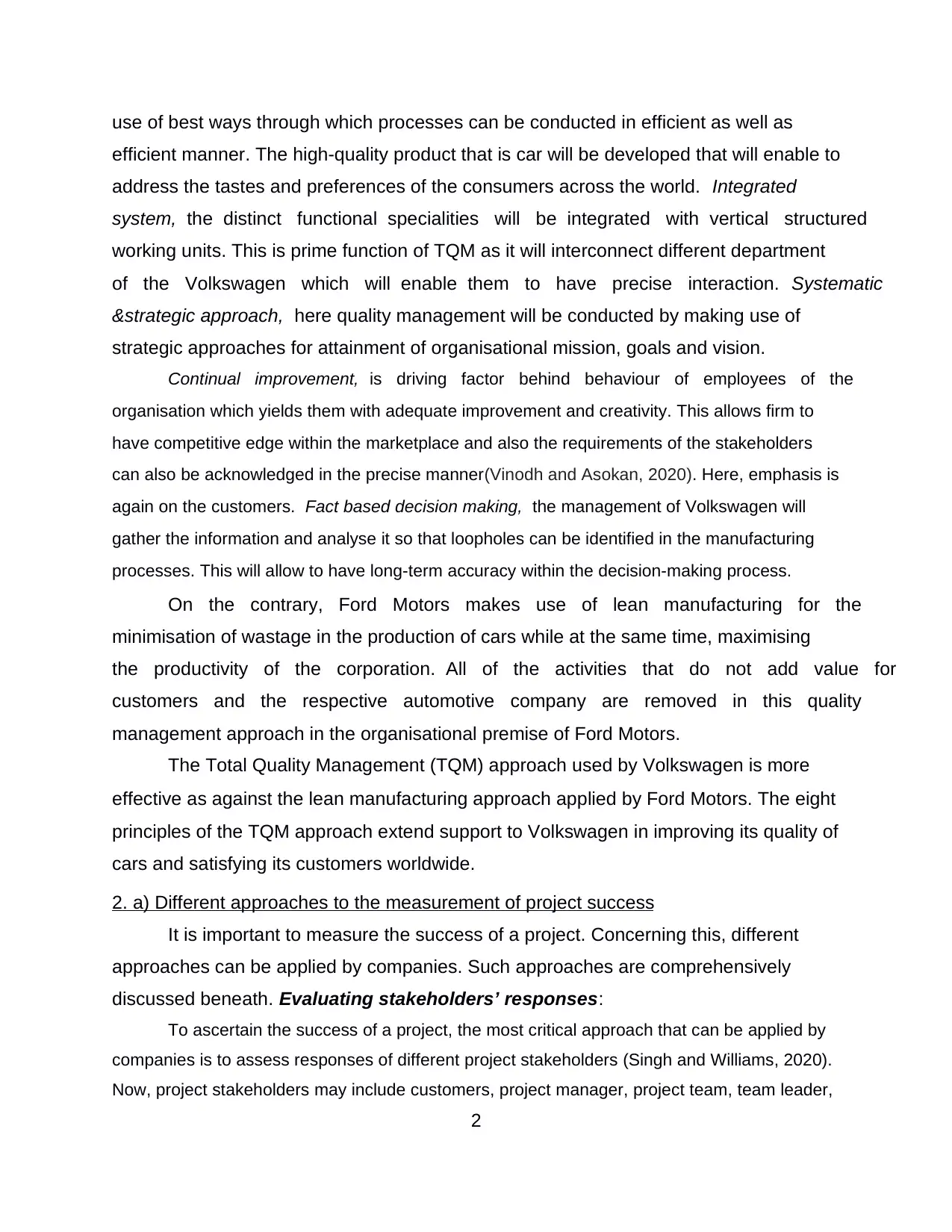
use of best ways through which processes can be conducted in efficient as well as
efficient manner. The high-quality product that is car will be developed that will enable to
address the tastes and preferences of the consumers across the world. Integrated
system, the distinct functional specialities will be integrated with vertical structured
working units. This is prime function of TQM as it will interconnect different department
of the Volkswagen which will enable them to have precise interaction. Systematic
&strategic approach, here quality management will be conducted by making use of
strategic approaches for attainment of organisational mission, goals and vision.
Continual improvement, is driving factor behind behaviour of employees of the
organisation which yields them with adequate improvement and creativity. This allows firm to
have competitive edge within the marketplace and also the requirements of the stakeholders
can also be acknowledged in the precise manner(Vinodh and Asokan, 2020). Here, emphasis is
again on the customers. Fact based decision making, the management of Volkswagen will
gather the information and analyse it so that loopholes can be identified in the manufacturing
processes. This will allow to have long-term accuracy within the decision-making process.
On the contrary, Ford Motors makes use of lean manufacturing for the
minimisation of wastage in the production of cars while at the same time, maximising
the productivity of the corporation. All of the activities that do not add value for
customers and the respective automotive company are removed in this quality
management approach in the organisational premise of Ford Motors.
The Total Quality Management (TQM) approach used by Volkswagen is more
effective as against the lean manufacturing approach applied by Ford Motors. The eight
principles of the TQM approach extend support to Volkswagen in improving its quality of
cars and satisfying its customers worldwide.
2. a) Different approaches to the measurement of project success
It is important to measure the success of a project. Concerning this, different
approaches can be applied by companies. Such approaches are comprehensively
discussed beneath. Evaluating stakeholders’ responses:
To ascertain the success of a project, the most critical approach that can be applied by
companies is to assess responses of different project stakeholders (Singh and Williams, 2020).
Now, project stakeholders may include customers, project manager, project team, team leader,
2
efficient manner. The high-quality product that is car will be developed that will enable to
address the tastes and preferences of the consumers across the world. Integrated
system, the distinct functional specialities will be integrated with vertical structured
working units. This is prime function of TQM as it will interconnect different department
of the Volkswagen which will enable them to have precise interaction. Systematic
&strategic approach, here quality management will be conducted by making use of
strategic approaches for attainment of organisational mission, goals and vision.
Continual improvement, is driving factor behind behaviour of employees of the
organisation which yields them with adequate improvement and creativity. This allows firm to
have competitive edge within the marketplace and also the requirements of the stakeholders
can also be acknowledged in the precise manner(Vinodh and Asokan, 2020). Here, emphasis is
again on the customers. Fact based decision making, the management of Volkswagen will
gather the information and analyse it so that loopholes can be identified in the manufacturing
processes. This will allow to have long-term accuracy within the decision-making process.
On the contrary, Ford Motors makes use of lean manufacturing for the
minimisation of wastage in the production of cars while at the same time, maximising
the productivity of the corporation. All of the activities that do not add value for
customers and the respective automotive company are removed in this quality
management approach in the organisational premise of Ford Motors.
The Total Quality Management (TQM) approach used by Volkswagen is more
effective as against the lean manufacturing approach applied by Ford Motors. The eight
principles of the TQM approach extend support to Volkswagen in improving its quality of
cars and satisfying its customers worldwide.
2. a) Different approaches to the measurement of project success
It is important to measure the success of a project. Concerning this, different
approaches can be applied by companies. Such approaches are comprehensively
discussed beneath. Evaluating stakeholders’ responses:
To ascertain the success of a project, the most critical approach that can be applied by
companies is to assess responses of different project stakeholders (Singh and Williams, 2020).
Now, project stakeholders may include customers, project manager, project team, team leader,
2
Paraphrase This Document
Need a fresh take? Get an instant paraphrase of this document with our AI Paraphraser
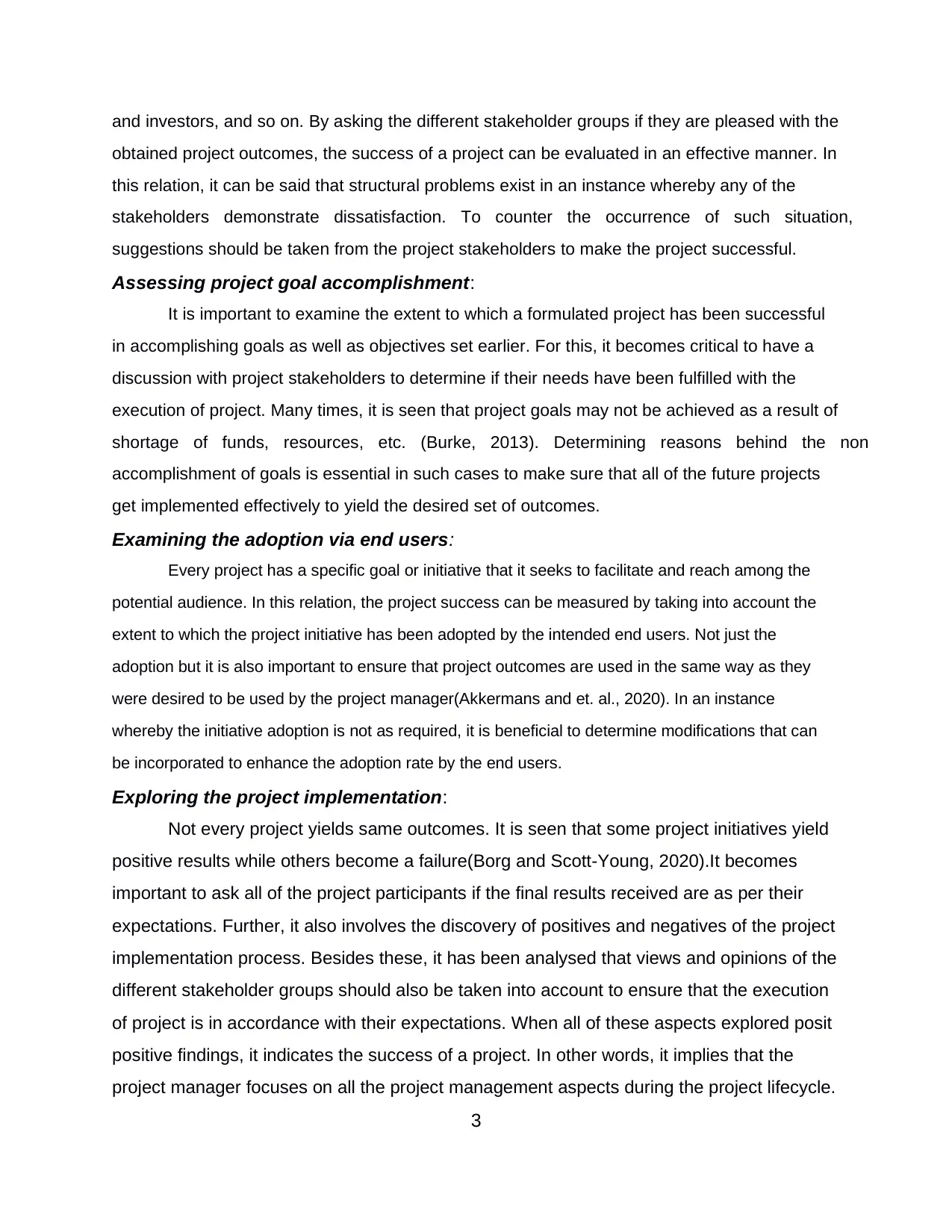
and investors, and so on. By asking the different stakeholder groups if they are pleased with the
obtained project outcomes, the success of a project can be evaluated in an effective manner. In
this relation, it can be said that structural problems exist in an instance whereby any of the
stakeholders demonstrate dissatisfaction. To counter the occurrence of such situation,
suggestions should be taken from the project stakeholders to make the project successful.
Assessing project goal accomplishment:
It is important to examine the extent to which a formulated project has been successful
in accomplishing goals as well as objectives set earlier. For this, it becomes critical to have a
discussion with project stakeholders to determine if their needs have been fulfilled with the
execution of project. Many times, it is seen that project goals may not be achieved as a result of
shortage of funds, resources, etc. (Burke, 2013). Determining reasons behind the non
accomplishment of goals is essential in such cases to make sure that all of the future projects
get implemented effectively to yield the desired set of outcomes.
Examining the adoption via end users:
Every project has a specific goal or initiative that it seeks to facilitate and reach among the
potential audience. In this relation, the project success can be measured by taking into account the
extent to which the project initiative has been adopted by the intended end users. Not just the
adoption but it is also important to ensure that project outcomes are used in the same way as they
were desired to be used by the project manager(Akkermans and et. al., 2020). In an instance
whereby the initiative adoption is not as required, it is beneficial to determine modifications that can
be incorporated to enhance the adoption rate by the end users.
Exploring the project implementation:
Not every project yields same outcomes. It is seen that some project initiatives yield
positive results while others become a failure(Borg and Scott-Young, 2020).It becomes
important to ask all of the project participants if the final results received are as per their
expectations. Further, it also involves the discovery of positives and negatives of the project
implementation process. Besides these, it has been analysed that views and opinions of the
different stakeholder groups should also be taken into account to ensure that the execution
of project is in accordance with their expectations. When all of these aspects explored posit
positive findings, it indicates the success of a project. In other words, it implies that the
project manager focuses on all the project management aspects during the project lifecycle.
3
obtained project outcomes, the success of a project can be evaluated in an effective manner. In
this relation, it can be said that structural problems exist in an instance whereby any of the
stakeholders demonstrate dissatisfaction. To counter the occurrence of such situation,
suggestions should be taken from the project stakeholders to make the project successful.
Assessing project goal accomplishment:
It is important to examine the extent to which a formulated project has been successful
in accomplishing goals as well as objectives set earlier. For this, it becomes critical to have a
discussion with project stakeholders to determine if their needs have been fulfilled with the
execution of project. Many times, it is seen that project goals may not be achieved as a result of
shortage of funds, resources, etc. (Burke, 2013). Determining reasons behind the non
accomplishment of goals is essential in such cases to make sure that all of the future projects
get implemented effectively to yield the desired set of outcomes.
Examining the adoption via end users:
Every project has a specific goal or initiative that it seeks to facilitate and reach among the
potential audience. In this relation, the project success can be measured by taking into account the
extent to which the project initiative has been adopted by the intended end users. Not just the
adoption but it is also important to ensure that project outcomes are used in the same way as they
were desired to be used by the project manager(Akkermans and et. al., 2020). In an instance
whereby the initiative adoption is not as required, it is beneficial to determine modifications that can
be incorporated to enhance the adoption rate by the end users.
Exploring the project implementation:
Not every project yields same outcomes. It is seen that some project initiatives yield
positive results while others become a failure(Borg and Scott-Young, 2020).It becomes
important to ask all of the project participants if the final results received are as per their
expectations. Further, it also involves the discovery of positives and negatives of the project
implementation process. Besides these, it has been analysed that views and opinions of the
different stakeholder groups should also be taken into account to ensure that the execution
of project is in accordance with their expectations. When all of these aspects explored posit
positive findings, it indicates the success of a project. In other words, it implies that the
project manager focuses on all the project management aspects during the project lifecycle.
3
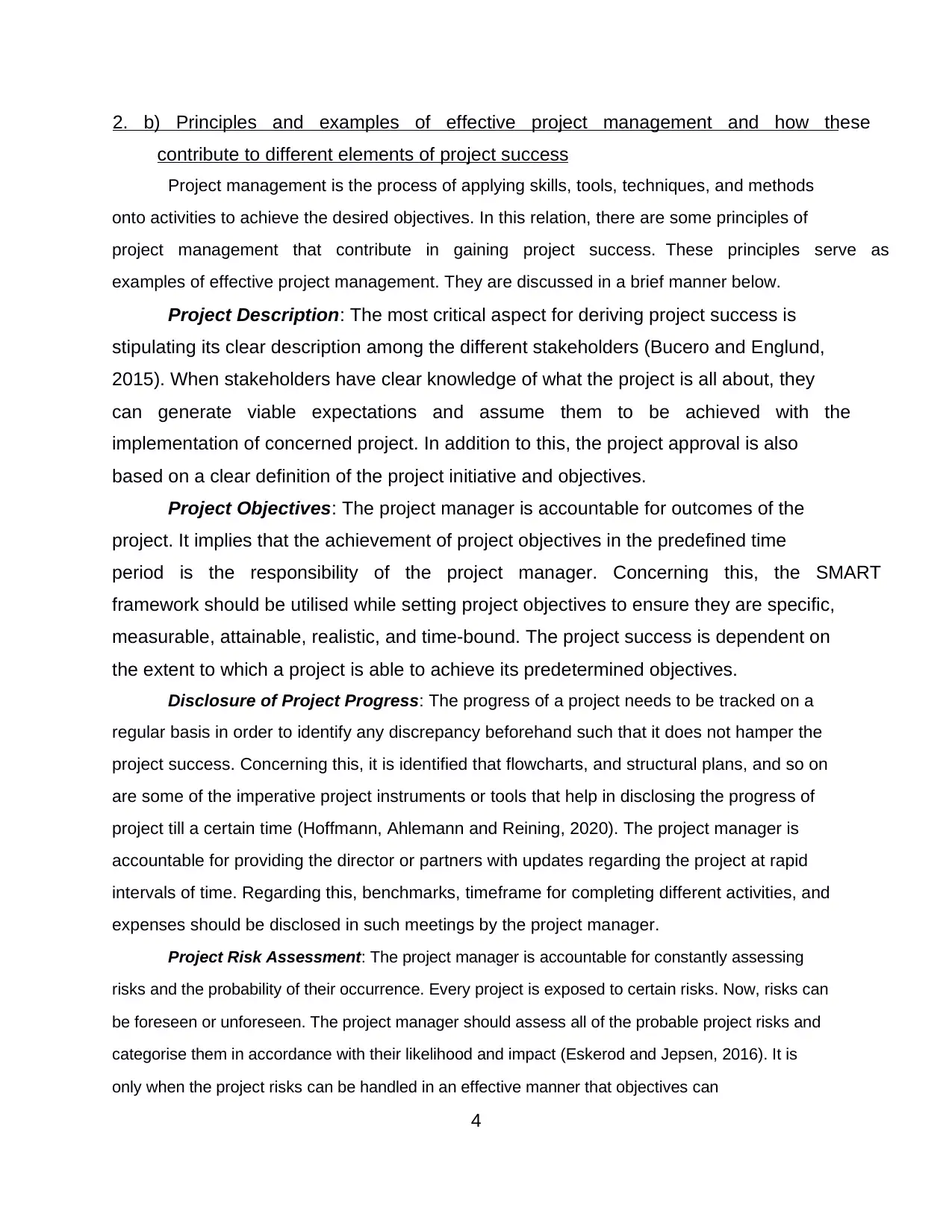
2. b) Principles and examples of effective project management and how these
contribute to different elements of project success
Project management is the process of applying skills, tools, techniques, and methods
onto activities to achieve the desired objectives. In this relation, there are some principles of
project management that contribute in gaining project success. These principles serve as
examples of effective project management. They are discussed in a brief manner below.
Project Description: The most critical aspect for deriving project success is
stipulating its clear description among the different stakeholders (Bucero and Englund,
2015). When stakeholders have clear knowledge of what the project is all about, they
can generate viable expectations and assume them to be achieved with the
implementation of concerned project. In addition to this, the project approval is also
based on a clear definition of the project initiative and objectives.
Project Objectives: The project manager is accountable for outcomes of the
project. It implies that the achievement of project objectives in the predefined time
period is the responsibility of the project manager. Concerning this, the SMART
framework should be utilised while setting project objectives to ensure they are specific,
measurable, attainable, realistic, and time-bound. The project success is dependent on
the extent to which a project is able to achieve its predetermined objectives.
Disclosure of Project Progress: The progress of a project needs to be tracked on a
regular basis in order to identify any discrepancy beforehand such that it does not hamper the
project success. Concerning this, it is identified that flowcharts, and structural plans, and so on
are some of the imperative project instruments or tools that help in disclosing the progress of
project till a certain time (Hoffmann, Ahlemann and Reining, 2020). The project manager is
accountable for providing the director or partners with updates regarding the project at rapid
intervals of time. Regarding this, benchmarks, timeframe for completing different activities, and
expenses should be disclosed in such meetings by the project manager.
Project Risk Assessment: The project manager is accountable for constantly assessing
risks and the probability of their occurrence. Every project is exposed to certain risks. Now, risks can
be foreseen or unforeseen. The project manager should assess all of the probable project risks and
categorise them in accordance with their likelihood and impact (Eskerod and Jepsen, 2016). It is
only when the project risks can be handled in an effective manner that objectives can
4
contribute to different elements of project success
Project management is the process of applying skills, tools, techniques, and methods
onto activities to achieve the desired objectives. In this relation, there are some principles of
project management that contribute in gaining project success. These principles serve as
examples of effective project management. They are discussed in a brief manner below.
Project Description: The most critical aspect for deriving project success is
stipulating its clear description among the different stakeholders (Bucero and Englund,
2015). When stakeholders have clear knowledge of what the project is all about, they
can generate viable expectations and assume them to be achieved with the
implementation of concerned project. In addition to this, the project approval is also
based on a clear definition of the project initiative and objectives.
Project Objectives: The project manager is accountable for outcomes of the
project. It implies that the achievement of project objectives in the predefined time
period is the responsibility of the project manager. Concerning this, the SMART
framework should be utilised while setting project objectives to ensure they are specific,
measurable, attainable, realistic, and time-bound. The project success is dependent on
the extent to which a project is able to achieve its predetermined objectives.
Disclosure of Project Progress: The progress of a project needs to be tracked on a
regular basis in order to identify any discrepancy beforehand such that it does not hamper the
project success. Concerning this, it is identified that flowcharts, and structural plans, and so on
are some of the imperative project instruments or tools that help in disclosing the progress of
project till a certain time (Hoffmann, Ahlemann and Reining, 2020). The project manager is
accountable for providing the director or partners with updates regarding the project at rapid
intervals of time. Regarding this, benchmarks, timeframe for completing different activities, and
expenses should be disclosed in such meetings by the project manager.
Project Risk Assessment: The project manager is accountable for constantly assessing
risks and the probability of their occurrence. Every project is exposed to certain risks. Now, risks can
be foreseen or unforeseen. The project manager should assess all of the probable project risks and
categorise them in accordance with their likelihood and impact (Eskerod and Jepsen, 2016). It is
only when the project risks can be handled in an effective manner that objectives can
4
⊘ This is a preview!⊘
Do you want full access?
Subscribe today to unlock all pages.

Trusted by 1+ million students worldwide
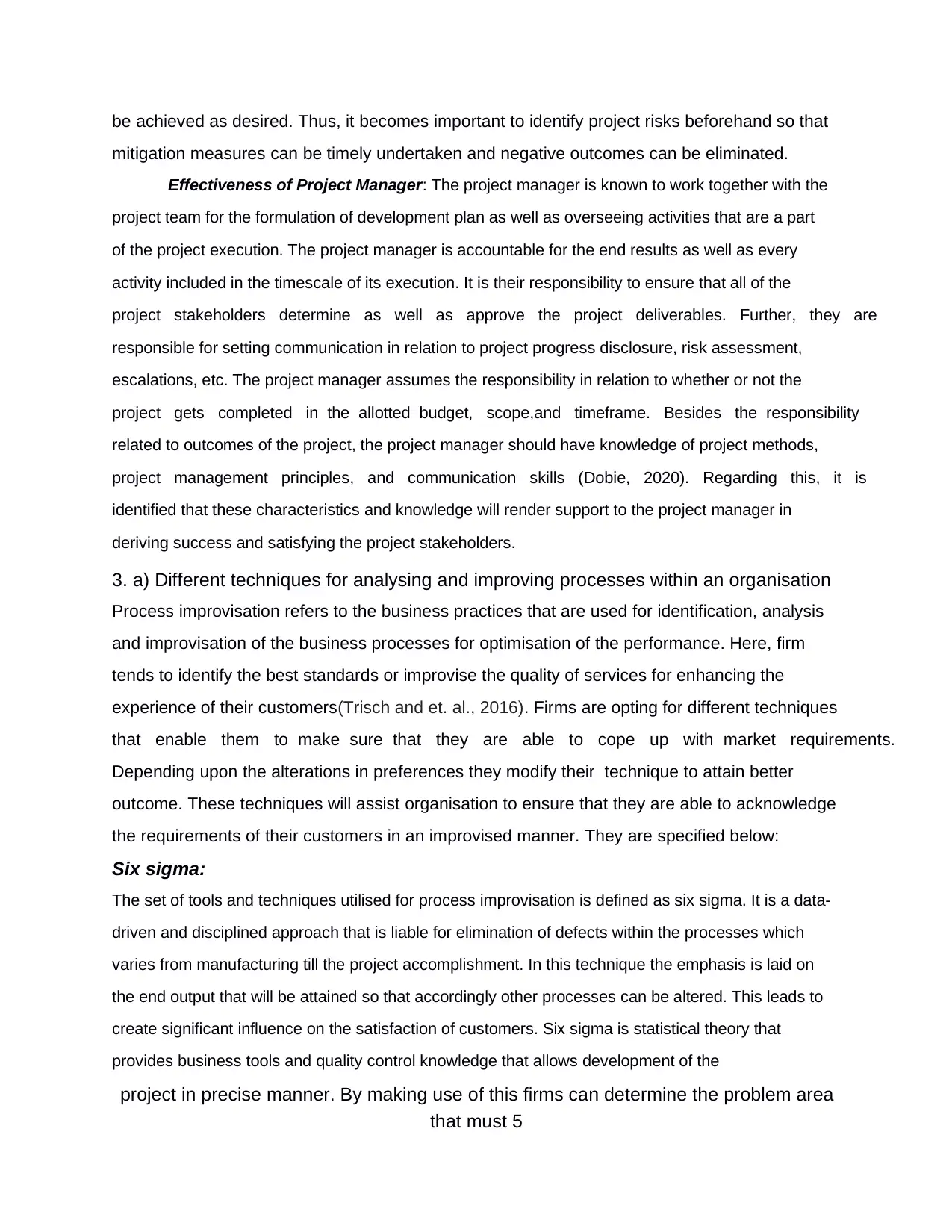
be achieved as desired. Thus, it becomes important to identify project risks beforehand so that
mitigation measures can be timely undertaken and negative outcomes can be eliminated.
Effectiveness of Project Manager: The project manager is known to work together with the
project team for the formulation of development plan as well as overseeing activities that are a part
of the project execution. The project manager is accountable for the end results as well as every
activity included in the timescale of its execution. It is their responsibility to ensure that all of the
project stakeholders determine as well as approve the project deliverables. Further, they are
responsible for setting communication in relation to project progress disclosure, risk assessment,
escalations, etc. The project manager assumes the responsibility in relation to whether or not the
project gets completed in the allotted budget, scope,and timeframe. Besides the responsibility
related to outcomes of the project, the project manager should have knowledge of project methods,
project management principles, and communication skills (Dobie, 2020). Regarding this, it is
identified that these characteristics and knowledge will render support to the project manager in
deriving success and satisfying the project stakeholders.
3. a) Different techniques for analysing and improving processes within an organisation
Process improvisation refers to the business practices that are used for identification, analysis
and improvisation of the business processes for optimisation of the performance. Here, firm
tends to identify the best standards or improvise the quality of services for enhancing the
experience of their customers(Trisch and et. al., 2016). Firms are opting for different techniques
that enable them to make sure that they are able to cope up with market requirements.
Depending upon the alterations in preferences they modify their technique to attain better
outcome. These techniques will assist organisation to ensure that they are able to acknowledge
the requirements of their customers in an improvised manner. They are specified below:
Six sigma:
The set of tools and techniques utilised for process improvisation is defined as six sigma. It is a data-
driven and disciplined approach that is liable for elimination of defects within the processes which
varies from manufacturing till the project accomplishment. In this technique the emphasis is laid on
the end output that will be attained so that accordingly other processes can be altered. This leads to
create significant influence on the satisfaction of customers. Six sigma is statistical theory that
provides business tools and quality control knowledge that allows development of the
project in precise manner. By making use of this firms can determine the problem area
that must 5
mitigation measures can be timely undertaken and negative outcomes can be eliminated.
Effectiveness of Project Manager: The project manager is known to work together with the
project team for the formulation of development plan as well as overseeing activities that are a part
of the project execution. The project manager is accountable for the end results as well as every
activity included in the timescale of its execution. It is their responsibility to ensure that all of the
project stakeholders determine as well as approve the project deliverables. Further, they are
responsible for setting communication in relation to project progress disclosure, risk assessment,
escalations, etc. The project manager assumes the responsibility in relation to whether or not the
project gets completed in the allotted budget, scope,and timeframe. Besides the responsibility
related to outcomes of the project, the project manager should have knowledge of project methods,
project management principles, and communication skills (Dobie, 2020). Regarding this, it is
identified that these characteristics and knowledge will render support to the project manager in
deriving success and satisfying the project stakeholders.
3. a) Different techniques for analysing and improving processes within an organisation
Process improvisation refers to the business practices that are used for identification, analysis
and improvisation of the business processes for optimisation of the performance. Here, firm
tends to identify the best standards or improvise the quality of services for enhancing the
experience of their customers(Trisch and et. al., 2016). Firms are opting for different techniques
that enable them to make sure that they are able to cope up with market requirements.
Depending upon the alterations in preferences they modify their technique to attain better
outcome. These techniques will assist organisation to ensure that they are able to acknowledge
the requirements of their customers in an improvised manner. They are specified below:
Six sigma:
The set of tools and techniques utilised for process improvisation is defined as six sigma. It is a data-
driven and disciplined approach that is liable for elimination of defects within the processes which
varies from manufacturing till the project accomplishment. In this technique the emphasis is laid on
the end output that will be attained so that accordingly other processes can be altered. This leads to
create significant influence on the satisfaction of customers. Six sigma is statistical theory that
provides business tools and quality control knowledge that allows development of the
project in precise manner. By making use of this firms can determine the problem area
that must 5
Paraphrase This Document
Need a fresh take? Get an instant paraphrase of this document with our AI Paraphraser
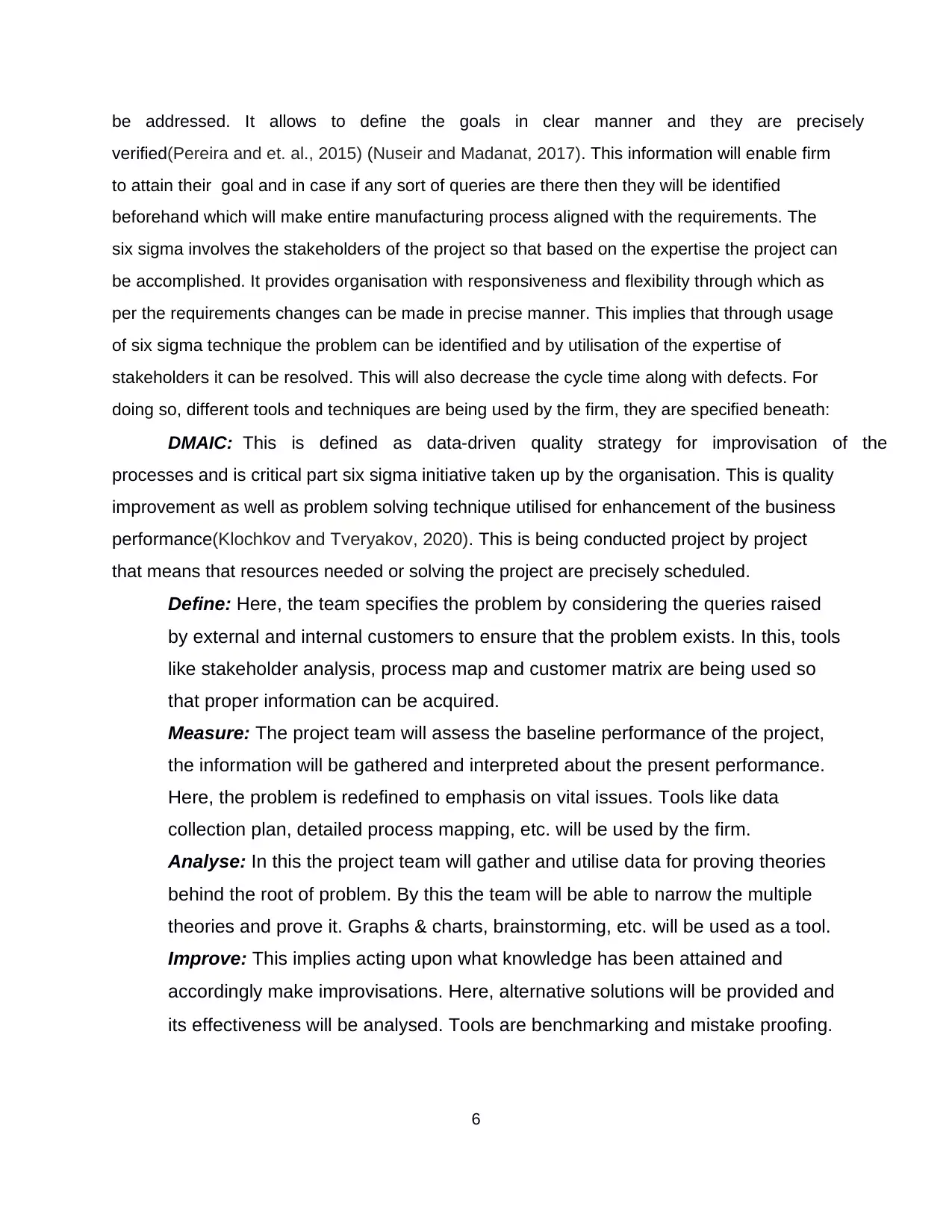
be addressed. It allows to define the goals in clear manner and they are precisely
verified(Pereira and et. al., 2015) (Nuseir and Madanat, 2017). This information will enable firm
to attain their goal and in case if any sort of queries are there then they will be identified
beforehand which will make entire manufacturing process aligned with the requirements. The
six sigma involves the stakeholders of the project so that based on the expertise the project can
be accomplished. It provides organisation with responsiveness and flexibility through which as
per the requirements changes can be made in precise manner. This implies that through usage
of six sigma technique the problem can be identified and by utilisation of the expertise of
stakeholders it can be resolved. This will also decrease the cycle time along with defects. For
doing so, different tools and techniques are being used by the firm, they are specified beneath:
DMAIC: This is defined as data-driven quality strategy for improvisation of the
processes and is critical part six sigma initiative taken up by the organisation. This is quality
improvement as well as problem solving technique utilised for enhancement of the business
performance(Klochkov and Tveryakov, 2020). This is being conducted project by project
that means that resources needed or solving the project are precisely scheduled.
Define: Here, the team specifies the problem by considering the queries raised
by external and internal customers to ensure that the problem exists. In this, tools
like stakeholder analysis, process map and customer matrix are being used so
that proper information can be acquired.
Measure: The project team will assess the baseline performance of the project,
the information will be gathered and interpreted about the present performance.
Here, the problem is redefined to emphasis on vital issues. Tools like data
collection plan, detailed process mapping, etc. will be used by the firm.
Analyse: In this the project team will gather and utilise data for proving theories
behind the root of problem. By this the team will be able to narrow the multiple
theories and prove it. Graphs & charts, brainstorming, etc. will be used as a tool.
Improve: This implies acting upon what knowledge has been attained and
accordingly make improvisations. Here, alternative solutions will be provided and
its effectiveness will be analysed. Tools are benchmarking and mistake proofing.
6
verified(Pereira and et. al., 2015) (Nuseir and Madanat, 2017). This information will enable firm
to attain their goal and in case if any sort of queries are there then they will be identified
beforehand which will make entire manufacturing process aligned with the requirements. The
six sigma involves the stakeholders of the project so that based on the expertise the project can
be accomplished. It provides organisation with responsiveness and flexibility through which as
per the requirements changes can be made in precise manner. This implies that through usage
of six sigma technique the problem can be identified and by utilisation of the expertise of
stakeholders it can be resolved. This will also decrease the cycle time along with defects. For
doing so, different tools and techniques are being used by the firm, they are specified beneath:
DMAIC: This is defined as data-driven quality strategy for improvisation of the
processes and is critical part six sigma initiative taken up by the organisation. This is quality
improvement as well as problem solving technique utilised for enhancement of the business
performance(Klochkov and Tveryakov, 2020). This is being conducted project by project
that means that resources needed or solving the project are precisely scheduled.
Define: Here, the team specifies the problem by considering the queries raised
by external and internal customers to ensure that the problem exists. In this, tools
like stakeholder analysis, process map and customer matrix are being used so
that proper information can be acquired.
Measure: The project team will assess the baseline performance of the project,
the information will be gathered and interpreted about the present performance.
Here, the problem is redefined to emphasis on vital issues. Tools like data
collection plan, detailed process mapping, etc. will be used by the firm.
Analyse: In this the project team will gather and utilise data for proving theories
behind the root of problem. By this the team will be able to narrow the multiple
theories and prove it. Graphs & charts, brainstorming, etc. will be used as a tool.
Improve: This implies acting upon what knowledge has been attained and
accordingly make improvisations. Here, alternative solutions will be provided and
its effectiveness will be analysed. Tools are benchmarking and mistake proofing.
6
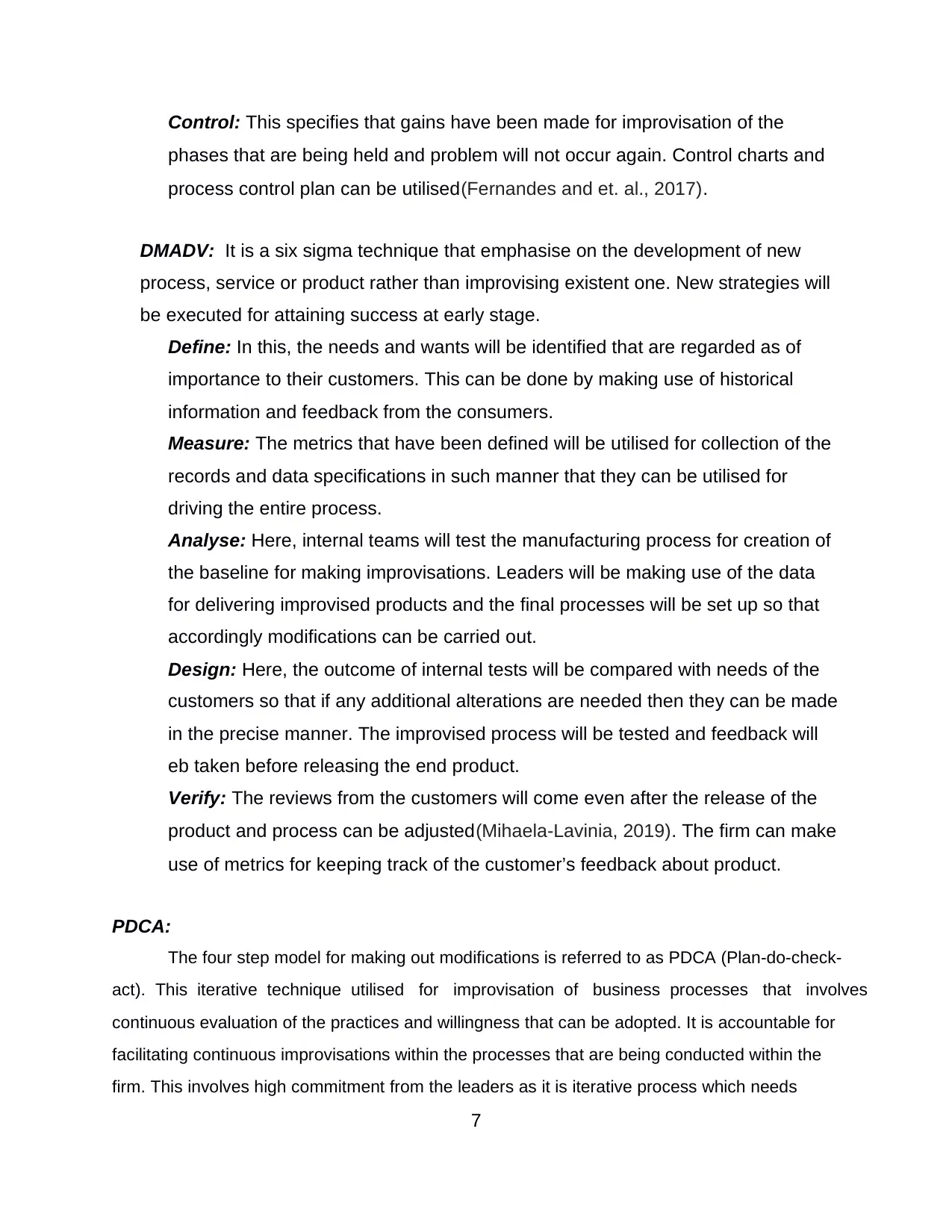
Control: This specifies that gains have been made for improvisation of the
phases that are being held and problem will not occur again. Control charts and
process control plan can be utilised(Fernandes and et. al., 2017).
DMADV: It is a six sigma technique that emphasise on the development of new
process, service or product rather than improvising existent one. New strategies will
be executed for attaining success at early stage.
Define: In this, the needs and wants will be identified that are regarded as of
importance to their customers. This can be done by making use of historical
information and feedback from the consumers.
Measure: The metrics that have been defined will be utilised for collection of the
records and data specifications in such manner that they can be utilised for
driving the entire process.
Analyse: Here, internal teams will test the manufacturing process for creation of
the baseline for making improvisations. Leaders will be making use of the data
for delivering improvised products and the final processes will be set up so that
accordingly modifications can be carried out.
Design: Here, the outcome of internal tests will be compared with needs of the
customers so that if any additional alterations are needed then they can be made
in the precise manner. The improvised process will be tested and feedback will
eb taken before releasing the end product.
Verify: The reviews from the customers will come even after the release of the
product and process can be adjusted(Mihaela-Lavinia, 2019). The firm can make
use of metrics for keeping track of the customer’s feedback about product.
PDCA:
The four step model for making out modifications is referred to as PDCA (Plan-do-check-
act). This iterative technique utilised for improvisation of business processes that involves
continuous evaluation of the practices and willingness that can be adopted. It is accountable for
facilitating continuous improvisations within the processes that are being conducted within the
firm. This involves high commitment from the leaders as it is iterative process which needs
7
phases that are being held and problem will not occur again. Control charts and
process control plan can be utilised(Fernandes and et. al., 2017).
DMADV: It is a six sigma technique that emphasise on the development of new
process, service or product rather than improvising existent one. New strategies will
be executed for attaining success at early stage.
Define: In this, the needs and wants will be identified that are regarded as of
importance to their customers. This can be done by making use of historical
information and feedback from the consumers.
Measure: The metrics that have been defined will be utilised for collection of the
records and data specifications in such manner that they can be utilised for
driving the entire process.
Analyse: Here, internal teams will test the manufacturing process for creation of
the baseline for making improvisations. Leaders will be making use of the data
for delivering improvised products and the final processes will be set up so that
accordingly modifications can be carried out.
Design: Here, the outcome of internal tests will be compared with needs of the
customers so that if any additional alterations are needed then they can be made
in the precise manner. The improvised process will be tested and feedback will
eb taken before releasing the end product.
Verify: The reviews from the customers will come even after the release of the
product and process can be adjusted(Mihaela-Lavinia, 2019). The firm can make
use of metrics for keeping track of the customer’s feedback about product.
PDCA:
The four step model for making out modifications is referred to as PDCA (Plan-do-check-
act). This iterative technique utilised for improvisation of business processes that involves
continuous evaluation of the practices and willingness that can be adopted. It is accountable for
facilitating continuous improvisations within the processes that are being conducted within the
firm. This involves high commitment from the leaders as it is iterative process which needs
7
⊘ This is a preview!⊘
Do you want full access?
Subscribe today to unlock all pages.

Trusted by 1+ million students worldwide
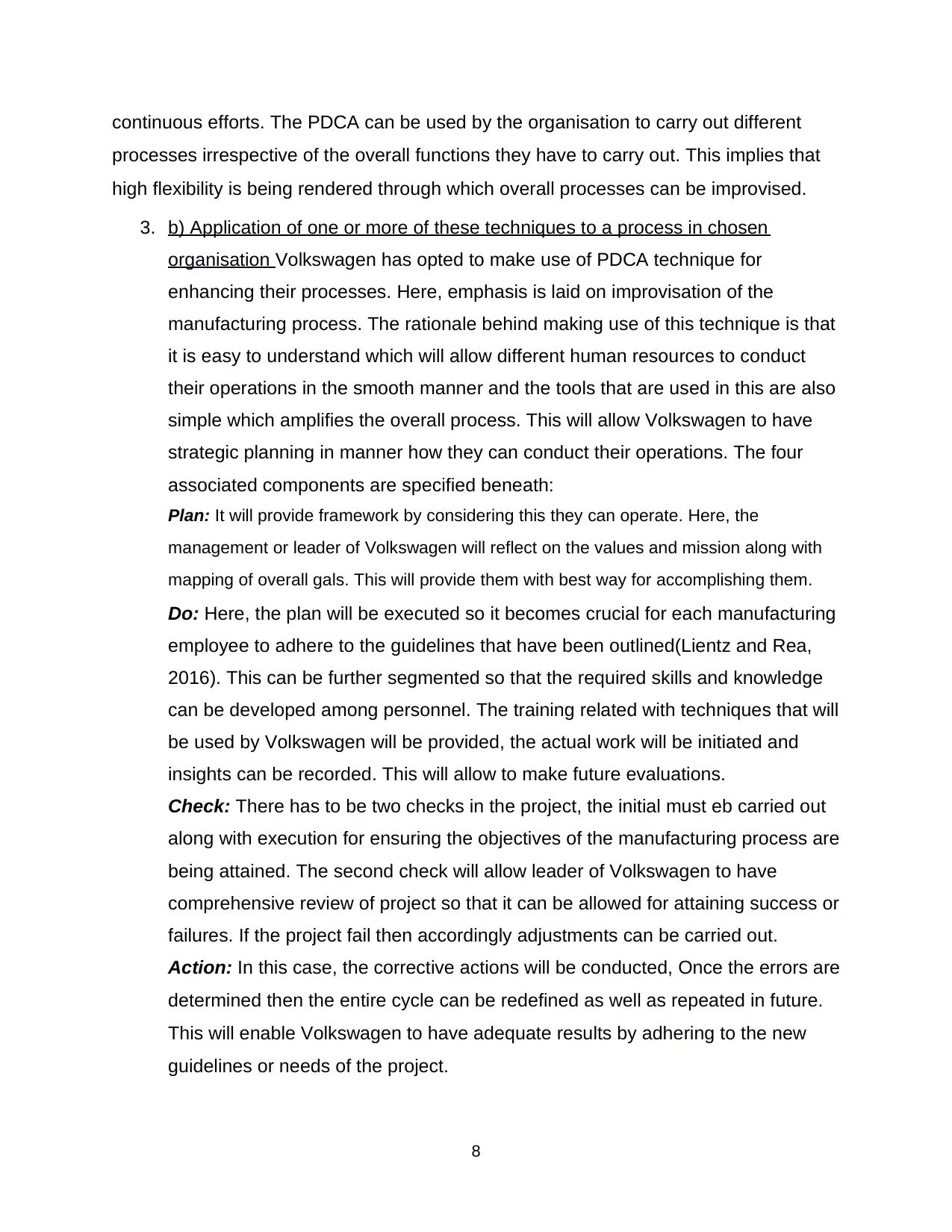
continuous efforts. The PDCA can be used by the organisation to carry out different
processes irrespective of the overall functions they have to carry out. This implies that
high flexibility is being rendered through which overall processes can be improvised.
3. b) Application of one or more of these techniques to a process in chosen
organisation Volkswagen has opted to make use of PDCA technique for
enhancing their processes. Here, emphasis is laid on improvisation of the
manufacturing process. The rationale behind making use of this technique is that
it is easy to understand which will allow different human resources to conduct
their operations in the smooth manner and the tools that are used in this are also
simple which amplifies the overall process. This will allow Volkswagen to have
strategic planning in manner how they can conduct their operations. The four
associated components are specified beneath:
Plan: It will provide framework by considering this they can operate. Here, the
management or leader of Volkswagen will reflect on the values and mission along with
mapping of overall gals. This will provide them with best way for accomplishing them.
Do: Here, the plan will be executed so it becomes crucial for each manufacturing
employee to adhere to the guidelines that have been outlined(Lientz and Rea,
2016). This can be further segmented so that the required skills and knowledge
can be developed among personnel. The training related with techniques that will
be used by Volkswagen will be provided, the actual work will be initiated and
insights can be recorded. This will allow to make future evaluations.
Check: There has to be two checks in the project, the initial must eb carried out
along with execution for ensuring the objectives of the manufacturing process are
being attained. The second check will allow leader of Volkswagen to have
comprehensive review of project so that it can be allowed for attaining success or
failures. If the project fail then accordingly adjustments can be carried out.
Action: In this case, the corrective actions will be conducted, Once the errors are
determined then the entire cycle can be redefined as well as repeated in future.
This will enable Volkswagen to have adequate results by adhering to the new
guidelines or needs of the project.
8
processes irrespective of the overall functions they have to carry out. This implies that
high flexibility is being rendered through which overall processes can be improvised.
3. b) Application of one or more of these techniques to a process in chosen
organisation Volkswagen has opted to make use of PDCA technique for
enhancing their processes. Here, emphasis is laid on improvisation of the
manufacturing process. The rationale behind making use of this technique is that
it is easy to understand which will allow different human resources to conduct
their operations in the smooth manner and the tools that are used in this are also
simple which amplifies the overall process. This will allow Volkswagen to have
strategic planning in manner how they can conduct their operations. The four
associated components are specified beneath:
Plan: It will provide framework by considering this they can operate. Here, the
management or leader of Volkswagen will reflect on the values and mission along with
mapping of overall gals. This will provide them with best way for accomplishing them.
Do: Here, the plan will be executed so it becomes crucial for each manufacturing
employee to adhere to the guidelines that have been outlined(Lientz and Rea,
2016). This can be further segmented so that the required skills and knowledge
can be developed among personnel. The training related with techniques that will
be used by Volkswagen will be provided, the actual work will be initiated and
insights can be recorded. This will allow to make future evaluations.
Check: There has to be two checks in the project, the initial must eb carried out
along with execution for ensuring the objectives of the manufacturing process are
being attained. The second check will allow leader of Volkswagen to have
comprehensive review of project so that it can be allowed for attaining success or
failures. If the project fail then accordingly adjustments can be carried out.
Action: In this case, the corrective actions will be conducted, Once the errors are
determined then the entire cycle can be redefined as well as repeated in future.
This will enable Volkswagen to have adequate results by adhering to the new
guidelines or needs of the project.
8
Paraphrase This Document
Need a fresh take? Get an instant paraphrase of this document with our AI Paraphraser
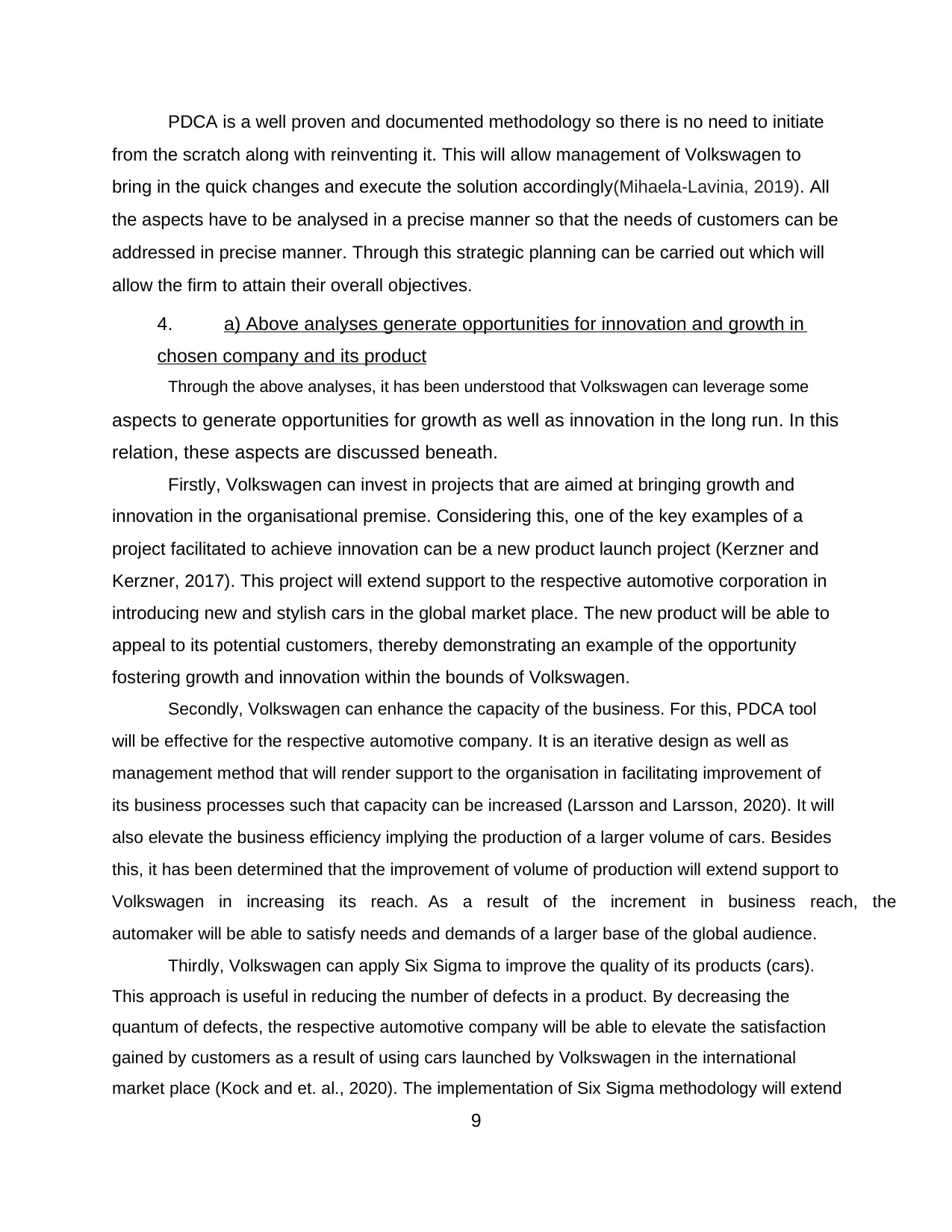
PDCA is a well proven and documented methodology so there is no need to initiate
from the scratch along with reinventing it. This will allow management of Volkswagen to
bring in the quick changes and execute the solution accordingly(Mihaela-Lavinia, 2019). All
the aspects have to be analysed in a precise manner so that the needs of customers can be
addressed in precise manner. Through this strategic planning can be carried out which will
allow the firm to attain their overall objectives.
4. a) Above analyses generate opportunities for innovation and growth in
chosen company and its product
Through the above analyses, it has been understood that Volkswagen can leverage some
aspects to generate opportunities for growth as well as innovation in the long run. In this
relation, these aspects are discussed beneath.
Firstly, Volkswagen can invest in projects that are aimed at bringing growth and
innovation in the organisational premise. Considering this, one of the key examples of a
project facilitated to achieve innovation can be a new product launch project (Kerzner and
Kerzner, 2017). This project will extend support to the respective automotive corporation in
introducing new and stylish cars in the global market place. The new product will be able to
appeal to its potential customers, thereby demonstrating an example of the opportunity
fostering growth and innovation within the bounds of Volkswagen.
Secondly, Volkswagen can enhance the capacity of the business. For this, PDCA tool
will be effective for the respective automotive company. It is an iterative design as well as
management method that will render support to the organisation in facilitating improvement of
its business processes such that capacity can be increased (Larsson and Larsson, 2020). It will
also elevate the business efficiency implying the production of a larger volume of cars. Besides
this, it has been determined that the improvement of volume of production will extend support to
Volkswagen in increasing its reach. As a result of the increment in business reach, the
automaker will be able to satisfy needs and demands of a larger base of the global audience.
Thirdly, Volkswagen can apply Six Sigma to improve the quality of its products (cars).
This approach is useful in reducing the number of defects in a product. By decreasing the
quantum of defects, the respective automotive company will be able to elevate the satisfaction
gained by customers as a result of using cars launched by Volkswagen in the international
market place (Kock and et. al., 2020). The implementation of Six Sigma methodology will extend
9
from the scratch along with reinventing it. This will allow management of Volkswagen to
bring in the quick changes and execute the solution accordingly(Mihaela-Lavinia, 2019). All
the aspects have to be analysed in a precise manner so that the needs of customers can be
addressed in precise manner. Through this strategic planning can be carried out which will
allow the firm to attain their overall objectives.
4. a) Above analyses generate opportunities for innovation and growth in
chosen company and its product
Through the above analyses, it has been understood that Volkswagen can leverage some
aspects to generate opportunities for growth as well as innovation in the long run. In this
relation, these aspects are discussed beneath.
Firstly, Volkswagen can invest in projects that are aimed at bringing growth and
innovation in the organisational premise. Considering this, one of the key examples of a
project facilitated to achieve innovation can be a new product launch project (Kerzner and
Kerzner, 2017). This project will extend support to the respective automotive corporation in
introducing new and stylish cars in the global market place. The new product will be able to
appeal to its potential customers, thereby demonstrating an example of the opportunity
fostering growth and innovation within the bounds of Volkswagen.
Secondly, Volkswagen can enhance the capacity of the business. For this, PDCA tool
will be effective for the respective automotive company. It is an iterative design as well as
management method that will render support to the organisation in facilitating improvement of
its business processes such that capacity can be increased (Larsson and Larsson, 2020). It will
also elevate the business efficiency implying the production of a larger volume of cars. Besides
this, it has been determined that the improvement of volume of production will extend support to
Volkswagen in increasing its reach. As a result of the increment in business reach, the
automaker will be able to satisfy needs and demands of a larger base of the global audience.
Thirdly, Volkswagen can apply Six Sigma to improve the quality of its products (cars).
This approach is useful in reducing the number of defects in a product. By decreasing the
quantum of defects, the respective automotive company will be able to elevate the satisfaction
gained by customers as a result of using cars launched by Volkswagen in the international
market place (Kock and et. al., 2020). The implementation of Six Sigma methodology will extend
9
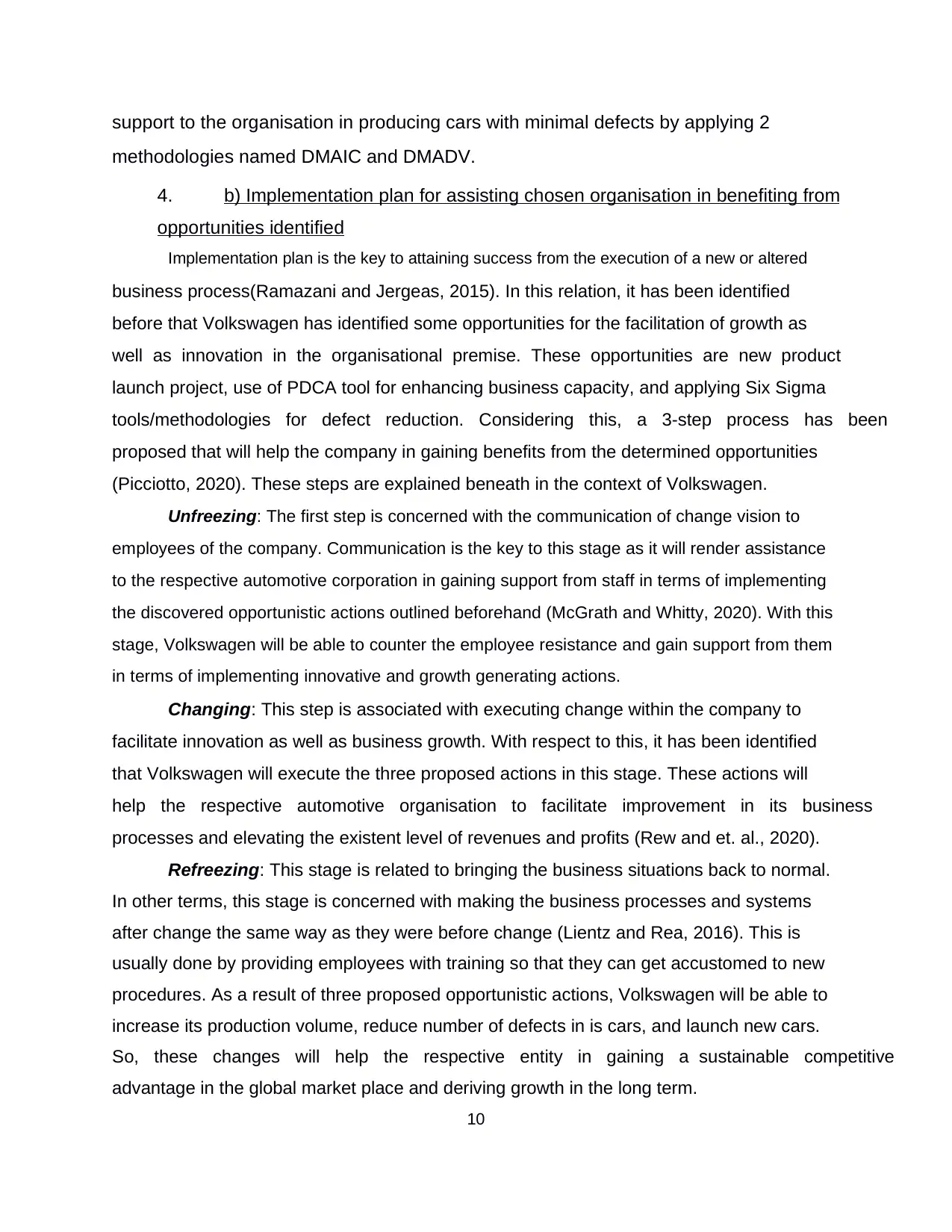
support to the organisation in producing cars with minimal defects by applying 2
methodologies named DMAIC and DMADV.
4. b) Implementation plan for assisting chosen organisation in benefiting from
opportunities identified
Implementation plan is the key to attaining success from the execution of a new or altered
business process(Ramazani and Jergeas, 2015). In this relation, it has been identified
before that Volkswagen has identified some opportunities for the facilitation of growth as
well as innovation in the organisational premise. These opportunities are new product
launch project, use of PDCA tool for enhancing business capacity, and applying Six Sigma
tools/methodologies for defect reduction. Considering this, a 3-step process has been
proposed that will help the company in gaining benefits from the determined opportunities
(Picciotto, 2020). These steps are explained beneath in the context of Volkswagen.
Unfreezing: The first step is concerned with the communication of change vision to
employees of the company. Communication is the key to this stage as it will render assistance
to the respective automotive corporation in gaining support from staff in terms of implementing
the discovered opportunistic actions outlined beforehand (McGrath and Whitty, 2020). With this
stage, Volkswagen will be able to counter the employee resistance and gain support from them
in terms of implementing innovative and growth generating actions.
Changing: This step is associated with executing change within the company to
facilitate innovation as well as business growth. With respect to this, it has been identified
that Volkswagen will execute the three proposed actions in this stage. These actions will
help the respective automotive organisation to facilitate improvement in its business
processes and elevating the existent level of revenues and profits (Rew and et. al., 2020).
Refreezing: This stage is related to bringing the business situations back to normal.
In other terms, this stage is concerned with making the business processes and systems
after change the same way as they were before change (Lientz and Rea, 2016). This is
usually done by providing employees with training so that they can get accustomed to new
procedures. As a result of three proposed opportunistic actions, Volkswagen will be able to
increase its production volume, reduce number of defects in is cars, and launch new cars.
So, these changes will help the respective entity in gaining a sustainable competitive
advantage in the global market place and deriving growth in the long term.
10
methodologies named DMAIC and DMADV.
4. b) Implementation plan for assisting chosen organisation in benefiting from
opportunities identified
Implementation plan is the key to attaining success from the execution of a new or altered
business process(Ramazani and Jergeas, 2015). In this relation, it has been identified
before that Volkswagen has identified some opportunities for the facilitation of growth as
well as innovation in the organisational premise. These opportunities are new product
launch project, use of PDCA tool for enhancing business capacity, and applying Six Sigma
tools/methodologies for defect reduction. Considering this, a 3-step process has been
proposed that will help the company in gaining benefits from the determined opportunities
(Picciotto, 2020). These steps are explained beneath in the context of Volkswagen.
Unfreezing: The first step is concerned with the communication of change vision to
employees of the company. Communication is the key to this stage as it will render assistance
to the respective automotive corporation in gaining support from staff in terms of implementing
the discovered opportunistic actions outlined beforehand (McGrath and Whitty, 2020). With this
stage, Volkswagen will be able to counter the employee resistance and gain support from them
in terms of implementing innovative and growth generating actions.
Changing: This step is associated with executing change within the company to
facilitate innovation as well as business growth. With respect to this, it has been identified
that Volkswagen will execute the three proposed actions in this stage. These actions will
help the respective automotive organisation to facilitate improvement in its business
processes and elevating the existent level of revenues and profits (Rew and et. al., 2020).
Refreezing: This stage is related to bringing the business situations back to normal.
In other terms, this stage is concerned with making the business processes and systems
after change the same way as they were before change (Lientz and Rea, 2016). This is
usually done by providing employees with training so that they can get accustomed to new
procedures. As a result of three proposed opportunistic actions, Volkswagen will be able to
increase its production volume, reduce number of defects in is cars, and launch new cars.
So, these changes will help the respective entity in gaining a sustainable competitive
advantage in the global market place and deriving growth in the long term.
10
⊘ This is a preview!⊘
Do you want full access?
Subscribe today to unlock all pages.

Trusted by 1+ million students worldwide
1 out of 16
Related Documents
Your All-in-One AI-Powered Toolkit for Academic Success.
+13062052269
info@desklib.com
Available 24*7 on WhatsApp / Email
![[object Object]](/_next/static/media/star-bottom.7253800d.svg)
Unlock your academic potential
Copyright © 2020–2025 A2Z Services. All Rights Reserved. Developed and managed by ZUCOL.





